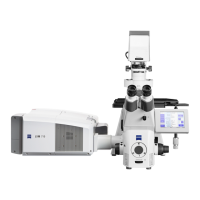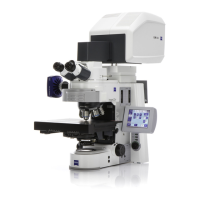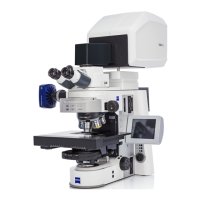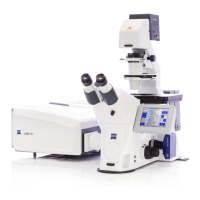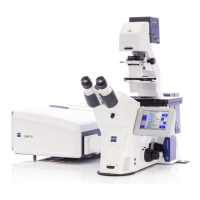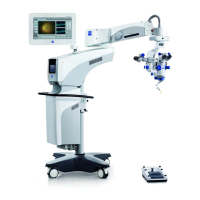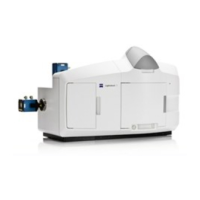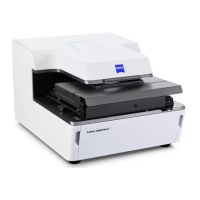Do you have a question about the Zeiss LSM 700 and is the answer not in the manual?
Important safety precautions and intended use guidelines for operating the LSM 700 microscope.
Steps to power on the main LSM 700 electronics and laser module.
Procedure for powering on HXP 120, HBO 100, or XBO 75 lamps for illumination.
How to activate the scanning stage via its controller if attached.
Explains how to activate or deactivate the 'Show All' mode for tool panel display.
Details on manually switching lasers on/off using the Laser Control tool.
Guides switching between direct visual observation and laser scanning modes.
Procedure for selecting and engaging microscope objective lenses.
Steps for focusing the microscope using transmitted light illumination.
How to save and recall microscope configurations for reproducible experiments.
Overview of the Smart Setup tool for automatic system configuration based on dyes.
Discusses advantages and disadvantages of simultaneous and sequential scanning modes.
Steps for manually setting up imaging configurations using the Light Path tool.
Visualizing emission spectra and laser lines for selected dyes.
How to store and retrieve custom track configurations for channel mode.
Options for switching tracks during scanning (line-by-line, frame-by-frame).
Adding, selecting, and removing tracks for multi-track configurations.
Adjusting frame size, pixel dwell, and averaging for image acquisition.
Using the scan speed slider to optimize image acquisition speed and quality.
Selecting bit depth for dynamic range to capture image intensity variations.
Optimizing image signal-to-noise ratio and optical slice thickness.
Activating the Range Indicator to visualize signal saturation in images.
Reducing laser power to prevent image saturation.
Modifying detector gain to optimize image brightness without saturation.
Important safety precautions and intended use guidelines for operating the LSM 700 microscope.
Steps to power on the main LSM 700 electronics and laser module.
Procedure for powering on HXP 120, HBO 100, or XBO 75 lamps for illumination.
How to activate the scanning stage via its controller if attached.
Explains how to activate or deactivate the 'Show All' mode for tool panel display.
Details on manually switching lasers on/off using the Laser Control tool.
Guides switching between direct visual observation and laser scanning modes.
Procedure for selecting and engaging microscope objective lenses.
Steps for focusing the microscope using transmitted light illumination.
How to save and recall microscope configurations for reproducible experiments.
Overview of the Smart Setup tool for automatic system configuration based on dyes.
Discusses advantages and disadvantages of simultaneous and sequential scanning modes.
Steps for manually setting up imaging configurations using the Light Path tool.
Visualizing emission spectra and laser lines for selected dyes.
How to store and retrieve custom track configurations for channel mode.
Options for switching tracks during scanning (line-by-line, frame-by-frame).
Adding, selecting, and removing tracks for multi-track configurations.
Adjusting frame size, pixel dwell, and averaging for image acquisition.
Using the scan speed slider to optimize image acquisition speed and quality.
Selecting bit depth for dynamic range to capture image intensity variations.
Optimizing image signal-to-noise ratio and optical slice thickness.
Activating the Range Indicator to visualize signal saturation in images.
Reducing laser power to prevent image saturation.
Modifying detector gain to optimize image brightness without saturation.
| Microscope Type | Confocal Laser Scanning Microscope |
|---|---|
| Laser Wavelengths | 405 nm, 488 nm, 555 nm, 639 nm |
| Scan Speed | Up to 8 frames per second at 512 x 512 pixels |
| Objective Magnification | 5x to 100x |
| Software | ZEN |
| Scanning Method | Galvanometric |
| Z-Stacking | Yes |
| Dimensions | Varies depending on configuration |
| Weight | Varies depending on configuration |
| Objective Lenses | Various objectives available (air, water, oil immersion) |
